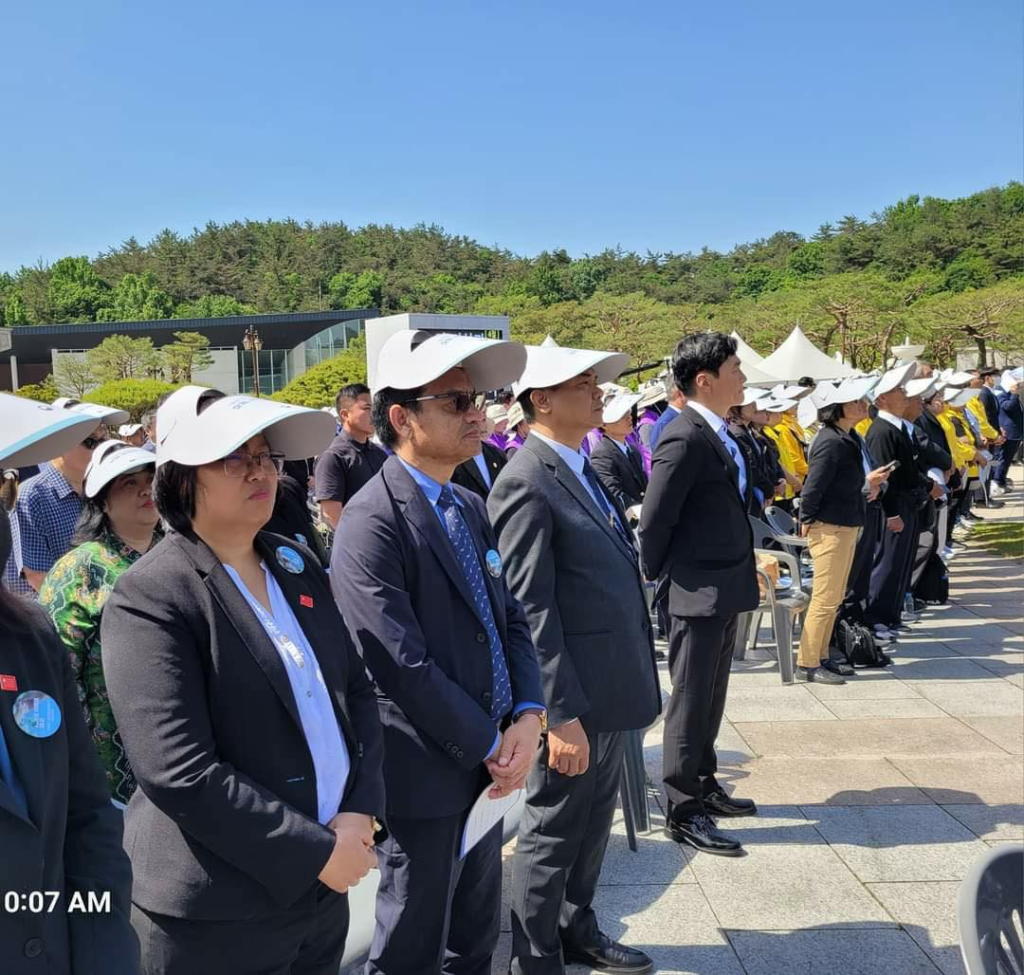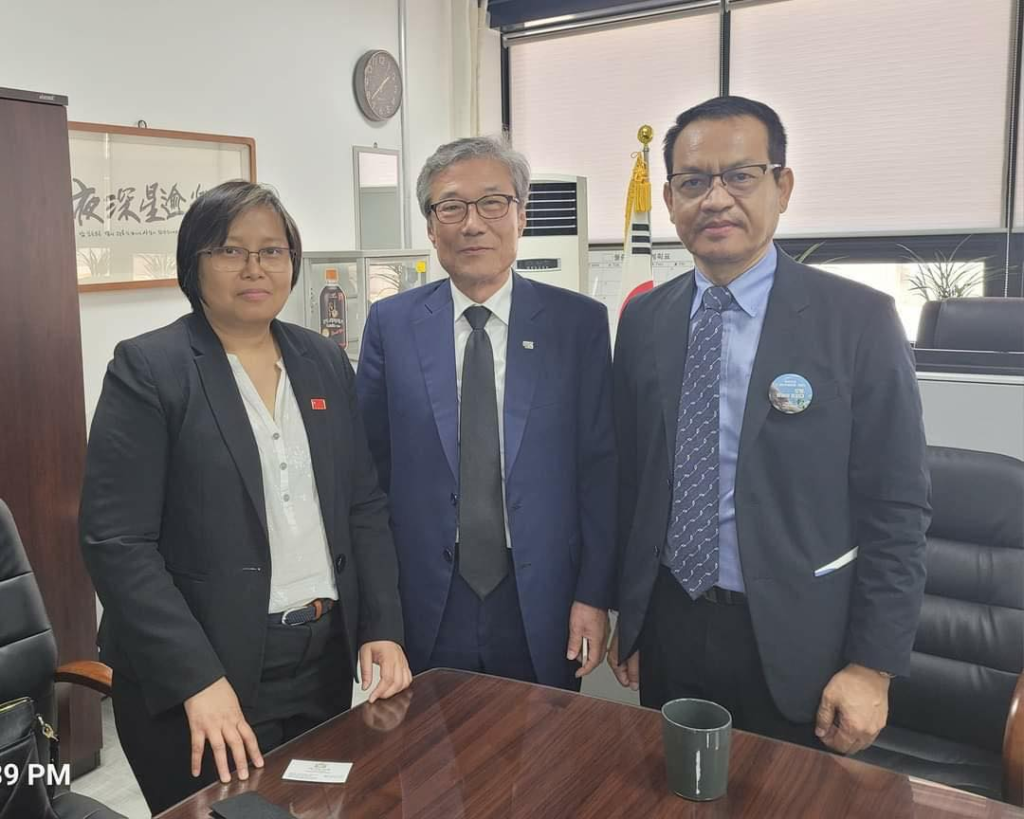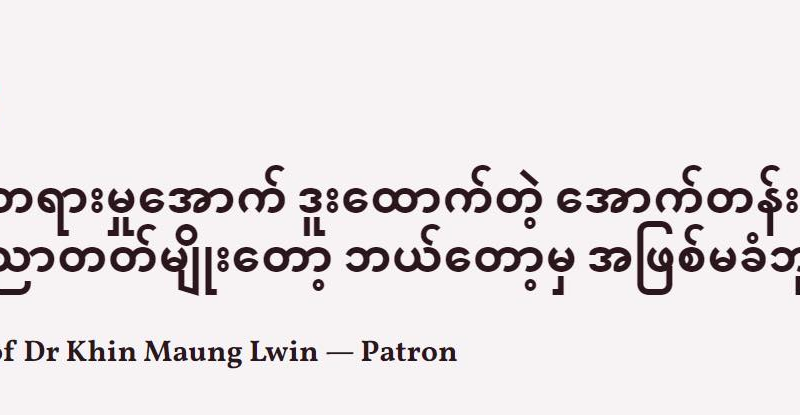Summary of News
Local News
- NUG Ministers attend Gwangju Prize for Human Rights 2024 Ceremony and meet with President of May 18 Memorial Foundation
- Union Minister U Aung Myo Min participates in town hall meeting and discussion at the University of British Columbia in Canada
- Ministry of Humanitarian Affairs and Disaster Management allocates 505.6 million kyats for humanitarian aid in April 2024
- Nway Oo Guru Lay Myar Education Centre transitions from diploma school to Karenni College of Social Science and Humanities
- Karenni Political Prisoner Association (KPPA) introduces research report on “Children’s Rights to Safe Education”
1. NUG Ministers attend Gwangju Prize for Human Rights 2024 Ceremony and meet with President of May 18 Memorial Foundation

Daw Zin Mar Aung, Union Minister for Foreign Affairs, and U Tin Tun Naing, Union Minister for Planning, Finance and Investment, of the National Unity Government, attended the Gwangju Prize for Human Rights 2024 ceremony on the evening of May 18. The Gwangju Prize for Human Rights 2024, awarded by the South Korean May 18 Memorial Foundation, was presented to Tamil women’s rights activist Suganthini Mathiyamuthan Thangaras from Sri Lanka. Notably, Daw Aung San Suu Kyi, U Min Ko Naing, and Dr. Cynthia Maung from Myanmar have previously received this prestigious award in 2004, 2009, and 2022, respectively.

During the event, the NUG ministers met with Sun-seok Won, Chairperson of the May 18 Foundation, and discussed the ongoing situations related to the Spring Revolution in Myanmar. Chairperson Sun-seok Won reaffirmed the foundation’s commitment to supporting Myanmar’s democratic movement as part of its broader mission to promote democracy worldwide. Additionally, Gwangju City Mayor Kang Ki-jeong warmly welcomed the NUG ministers.
2. Union Minister U Aung Myo Min participates in town hall meeting and discussion at the University of British Columbia in Canada
Union Minister U Aung Myo Min participated in a town hall meeting and discussion held by the Asia Pacific Foundation of Canada in partnership with the University of British Columbia’s School of Public Policy and Global Affairs (Institute of Asian Research), the UBC Myanmar Initiative, and Canada’s International Development Research Centre (IDRC) on May 18 at the University of British Columbia in Vancouver, Canada. Union Minister of Human Rights U Aung Myo Min and Deputy Minister of Human Rights U Aung Kyaw Moe served as panellists at the event.
The meeting was attended by members of the Myanmar community in Canada, researchers, and other interested parties. Discussions focused on the human rights situation in Myanmar and the ongoing efforts and challenges faced by the National Unity Government.



3. Ministry of Humanitarian Affairs and Disaster Management allocates 505.6 million kyats for humanitarian aid in April 2024
The Ministry of Humanitarian Affairs and Disaster Management of the National Unity Government has announced the disbursement of 505.6 million kyats in humanitarian aid during April 2024. The funds, sourced from public donations, were allocated as follows:
– 411.7 million kyats were used to provide emergency food aid to 424,005 internally displaced persons.- 29.2 million kyats were distributed as emergency humanitarian aid to 157 revolutionary heroes who had fallen in battles and 269 revolutionary heroes who were injured.- 12.5 million kyats supported Civil Disobedience Movement (CDM) civil servants.- 0.9 million kyats were allocated for political prisoners and their families.- 18.3 million kyats were spent on preparing food supplies for the general public.- 33 million kyats were used for general support.- Emergency food was provided to people temporarily displaced by fighting in Myawaddy township, Karen State.- The ministry also funded the construction of four shelters for those affected by military junta arson attacks and 11 bomb pits for interim public schools.

The ministry expressed its pride and appreciation for the resilience and contributions of citizens who have persevered through over three years of revolution, driven by the goal of achieving victory. They urged the public to maintain their zeal and continue supporting the revolution.
4. Nway Oo Guru Lay Myar Education Centre transitions from diploma school to Karenni College of Social Science and Humanities
Nway Oo Guru Lay Myar Education Centre, established post-coup and previously offering diploma courses in social sciences, announced on May 17 its upgrade to the Karenni College of Social Science and Humanities. Principal Daw Khin Sandar explained that the upgrade was due to advancements in teaching methods and the quality now meeting international diploma-level standards. “We believe we are ready in terms of teaching methods, quality, academic support, and recognition, which is why we changed the name to college,” she said.
The newly upgraded college will offer 18-month courses, comprising six months of foundation studies followed by a one-year intensive program. Applications for the first batch of students will open in June, with 40 to 45 students expected to be selected. The educational requirement for admission is at least some high school attendance, with applicants needing to pass a specified entrance exam.
Daw Khin Sandar mentioned, “We are using an entrance exam system. If one passes the exam, they will be eligible to enter the college. The basic requirement is high school attendance, even if they didn’t complete grades 10 or 11 under the old system but have to pass the admission test. It is also okay if they have passed grade 11 (matriculation) or have attended college but not finished.”
The college’s curriculum will include subjects such as social policy theory and practice, regional political systems, research design and methods, environmental studies, digital literacy, community development, media literacy and journalism, cultural diversity and social cohesion, as well as supplementary subjects like academic English, computer skills, and an introduction to social science. Despite the upgrade to a college, the institution will continue to offer short vocational courses.
5. Karenni Political Prisoner Association (KPPA) introduces research report on “Children’s Rights to Safe Education”
On May 18, the Karenni Political Prisoner Association (KPPA) held an event in western Demoso township to introduce their research report on “Children’s Rights to Safe Education,” as reported by Kantarawaddy Times. Ko Salmon from KPPA outlined the report’s objectives, stating, “This document aims to ensure a safe learning environment for children in Karenni State. Our children have faced significant challenges since the COVID pandemic and throughout the ongoing conflict. Even though it is under the military’s slavery education, urban children can still study peacefully. However, schools here are overshadowed by war. The danger from warfare can be mitigated if revolutionary comrades avoid their movements near schools as much as possible. Military affairs are heavily intertwined with education, so we want to control this situation.”
The event was attended by education unions, representatives from community schools, civil society organisations (CSOs), and others involved in the education sector. Ko Salmon emphasised the need for collaboration, saying, “Everybody wants to study safely, but as a study, no one has yet done that. We are documenting these concerns and amplifying the voices of the people. It would be beneficial for us to work together with educational communities on ensuring a completely safe and secure studying environment.”
The report’s findings are based on surveys conducted with approximately 1,000 parents, teachers, students, and education rights activists.
Military News
- Military’s artillery shelling in Thaton injures two, including a child, and destroys four houses
- KIA-led forces seize seven junta outposts in Waingmaw, intensify efforts to capture remaining bases
- Heavy casualties among junta troops following counter-attack by revolutionary forces near Tada-U and Nga Zun
- Arakan Army (AA) rescues 35 Muslims starved and locked up by military for three days in
Buthidaung - PDF forces launch attacks on Pyigyimandaing Town Police Station and Lenya River Bridge in Bokepyin
6. Military’s artillery shelling in Thaton injures two, including a child, and destroys four houses
19th May
The Karen National Union (KNU) headquarters released a report on May 19 detailing the impact of the military junta’s artillery shellings on civilians in Thaton township, Mon State. According to the KNU, the 9th Light Infantry Battalion (LIB-9), based in Thaton township, fired artillery shells at 10:15 a.m. on May 17, with three of the shells exploding inside villages in Vi Yaw village tract. This attack injured a 15-year-old girl and destroyed two houses.
Later, around 5:00 p.m., the 314th Artillery Battalion fired six rounds of artillery shells, four of which exploded inside a rubber farm along the motorway between Shwe Yaung Pya village and A Won Gyi village, destroying two more houses.
Additionally, on the evening of May 16, four artillery shells fired by LIB-9 exploded inside a rubber farm in Htone Bo Gyi village, injuring a 40-year-old man.
Previously, on the morning and afternoon of May 16, LIB-9 and the 314th Artillery Battalion fired artillery shells indiscriminately into civilian villages.
7. KIA-led forces seize seven junta outposts in Waingmaw, intensify efforts to capture remaining bases
Reports from news sources indicate that revolutionary forces led by the Kachin Independence Army (KIA) have recently captured at least seven military junta outposts in Waingmaw township, Kachin State. The situation in the township remains intense this morning, May 19, as KIA forces continue their efforts to capture the remaining bases.
The KIA-led forces launched synchronised offensives on at least 10 military junta bases and outposts in areas within Waingmaw township, including Shwe Nyaung Pin, Ka Tsu village, Gar Ra Rang village, and Da Bat Yan village, on May 18. These operations led to the capture of at least seven outposts, and the KIA forces continued their offensives against larger bases, including battalion headquarters in Waingmaw township.
On May 19, at 6:00 a.m., military junta troops captured the Lone Zet Kawng outpost near Gar Ra Rang village. Additionally, a factory and guard post stationed by military junta troops near the 321st Infantry Battalion were seized at 7:00 p.m. on May 18.
The KIA-led forces initiated their operations against military junta bases and outposts in Kachin State on March 7. Since then, they have managed to capture over 100 large and small bases of the military junta, including battalion headquarters and tactical outposts.
8. Heavy casualties among junta troops following counter-attack by revolutionary forces near Tada-U and Nga Zun
According to a report from revolutionary forces, a counter-attack was launched against military junta forces responsible for arson attacks on civilian villages near Tada-U and Nga Zun in Mandalay Region. The operation spanned three consecutive days and resulted in heavy casualties among junta troops.
On May 12, the revolutionary forces ambushed two military trucks on the road between Kywae Zein village and Na Wa Rat village within Tada-U township and Nga Zun township at 8:30 a.m., reportedly causing many casualties among the junta troops. Following the ambush, the junta forces raided the nearby Htan Ta Pin village, but the revolutionary forces managed to rescue residents in time. Subsequently, the revolutionary forces attacked the junta forces stationed inside Htan Ta Pin village using drones and artilleries. The junta forces retaliated with artillery shelling.
The following day, May 13, saw continued attacks by the revolutionary forces, which again used artillery shelling, leading to an exchange of artillery fire. On May 14, the engagement continued for about 45 minutes before the revolutionary forces safely retreated.
The operation was a joint effort by the Tada-U township people’s defence team, the Youths of Mandalay-YOM, Squadron 3 (Special Task Force—Nga Zun) of the 6th Battalion of the People’s Defence Force (PDF) under Myingyan District, Ayewaddy Prince, and the Shwe Joe Phyu people’s defence team.
9. Arakan Army (AA) rescues 35 Muslims starved and locked up by military for three days in Buthidaung
On May 18, the Arakan Army (AA) released video footage showing the rescue of 35 Muslims who had been locked up by the military without food and water for three days in Buthidaung, Rakhine State. These individuals are reportedly residents of Kha Yu Chaung village. The AA stated that they discovered and rescued them on May 14 when they captured and occupied the military junta’s 353rd Light Infantry Battalion (LIB-353) base in Buthidaung township.
Similarly, on the late evening of May 18, the AA released another video clip where they interviewed 22 Muslims who had fled from military arrests for forced recruitment on May 16. These individuals are residents of Kyauk Phyu Taung village and had fled because the military junta’s 378th Artillery Battalion was taking adult Muslims to serve in the military, according to the AA. The AA found and rescued them 3.21 km southeast of Aung Zeya village.
10. PDF forces launch attacks on Pyigyimandaing Town Police Station and Lenya River Bridge in Bokepyin
The People’s Defence Force (PDF) Kawthaung District Battalion No. 1 (P23201) released a report that they had conducted attacks on the military junta’s police station in Pyigyimandaing town and a security checkpoint at Lenya River crossing bridge in Bokepyin at around 7:00 a.m. on May 17. During the attack, a drone was used to drop bombs, and it was stated that there might be casualties on the junta’s side, but this has not yet been confirmed. The military junta forces returned fire with guns and artillery, but the PDF comrades reportedly managed to retreat safely.
The operation was carried out jointly by Squadron 2 of the No. 1 PDF Battalion under Kawthaung District, Dragon Squad UAV Force, Kawthaung District UAV Force, and Squadron 1 of the No. 203 Battalion of the Karen National Liberation Army (KNLA).
#Credit : Radio NUG
#WhatsHappeningInMyanmar


